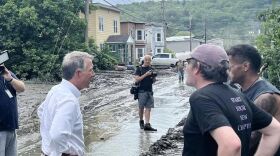One year ago, intense rain began to fall in the Northeast. The unrelenting downpours overfilled rivers and streams, fields and paddocks, leading to some of the worst flooding ever in the Green Mountain State. Vermont residents, businesses and farmers are still recovering from the devastation.
The National Weather Service refers to it as “The Great Vermont Flood of 10-11 July 2023” when up to 9 inches of rain fell in a 48-hour period. Many communities in the state set records and rivers across the state overflowed their banks. The catastrophe included flooded farm fields, homes and businesses, landslides, and road washouts.
The governor appointed a Chief Recovery Officer to guide the state through cleanup and long-term recovery. Doug Farnham says one year on, there’s still a lot to do.
“We definitely have long term recovery groups that are still working with hundreds of households to recover and to rebuild. The flood started in July but really the flooding went through August 5th. So we didn’t get a chance to even start our short term response and recovery until the beginning of August,” said Farnham. “And as you know the Vermont construction season being short, most of the rebuilding effort had to start this spring. So we’re really in our first real construction season. So I’d say from the individual side we still have a long way to go. On the state and the municipal repairs, we did all the emergency repairs but there’s a lot of permanent work that’s going to happen over the next couple of years. So a lot of the bigger, permanent work projects are just getting started.”
Agriculture was hard hit by the flooding with crops destroyed and fertile soils contaminated. Vermont Agriculture Secretary Anson Tebbetts says farmers are still dealing with the aftermath of the floods.
“The economic impact will be with them for a long period of time,” Tebbetts said. “If you take feed for example, so much feed was lost and also farmers were not able to harvest as much because of the wet weather. And then there’s the physical damage that happened to a lot of the land. You can still see debris. And of course the economic losses we figure is well over $75 million in economic damage from last year. That is an extremely big hit for our agriculture community to recover from in just a year’s time. So it will be with them for a while.”
Farnham says the state will be doing about $100 million in hazard mitigation projects including buyouts and flood plain restoration to lower the risk of flooding. He cautions that it will take years for full recovery, noting that one recovery project from 2011’s Tropical Storm Irene was completed just weeks before last year’s flood.
“We’ll still have some projects going on for five years, eight years, maybe even ten years depending on the nature of the project,” Farnham said. “The three-to-five-year time frame is most often used for states with this level of disaster and I would say that what we’re hearing from FEMA and what we’re hearing when we talk to other states is that we’re roughly on pace with other states. But I do think for us, for Vermonters, that feels like we’re behind. So I think we will have the majority of the construction work and the rebuilding efforts done within three years. But we will still have some situations that are tricky and we’re trying to work through after that.”
For the past year, Vermont Senator Peter Welch has advocated for federal assistance as the state works to recover from the floods. In his latest WAMC Congressional Corner appearance, the Democrat says this disaster and others highlight the need for federal investments in climate change resiliency.
“I’ve been taking a tour this past month of many of our hardest hit towns and just the work that still has to be done is significant,” Welch said. “You know, we’ve had 73 major disaster declarations in the past year. And a recent report came out saying it is costing all of us about a half-a-billion dollars a year. So we really have to do everything we can to have resilience be a part of recovery.”
The Vermont Agency of Natural Resources has maintained a website dedicated to flood recovery resources.


























